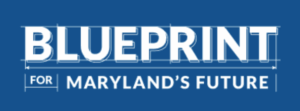Understanding the “Blueprint” & Its Impact on Pre-K Options
This post is part of Live Baltimore’s resources for families with children.
 If you’ve lived in Maryland over the past few years, you’ve likely heard about “The Blueprint.” However, unless you work in education policy, the details may still be fuzzy. Here’s what Baltimore City families with young children need to know.
If you’ve lived in Maryland over the past few years, you’ve likely heard about “The Blueprint.” However, unless you work in education policy, the details may still be fuzzy. Here’s what Baltimore City families with young children need to know.
What is the Blueprint for Maryland’s Future?
The Maryland General Assembly passed this landmark legislation in 2021 with the goal of transforming Maryland’s public education into a world-class system by increasing education funding over the next decade. The Blueprint outlines five pillars to enhance the quality of education for all children in the state, the first of which is early childhood education.
What is Pre-K Expansion and what does “mixed delivery” mean?
The Blueprint is based on research showing the benefits of high-quality early childhood education during a child’s first years. Children in high-quality Pre-K settings are much more prepared to begin Kindergarten and have a higher chance of success in school later. The Blueprint calls for expanding full-day Pre-K options so that income-eligible three- and four-year-olds can enroll. The Blueprint also increases funding for programs that offer, such as Judy Centers, Patty Centers, and Infants and Toddler programs. “Wraparound services” might include developmental screenings, early intervention identification, parenting classes, playgroups, and case management.
The Blueprint relies on a “mixed delivery” model to provide a Pre-K seat for every child who needs one, meaning that high-quality Pre-K is available in a range of settings. In addition to Baltimore City Public Schools, families can find no-cost Pre-K spaces at community-based childcare providers who have received Pre-K Expansion Grants from the Maryland State Department of Education. “Mixed delivery” and “Pre-K Expansion” both refer to these state-funded Pre-K options.
Baltimore City is ahead of other parts of Maryland in expanding Pre-K because City Schools have been offering free, full-day Pre-K for the past ten years, according to Rudi Zelner from the Fund for Educational Excellence. While there is still room to grow, Baltimore City has 4,200 seats in 210 classrooms at approximately 100 public schools for 2025-2026 in addition to about 500 spaces at 22 mixed-delivery sites. (Access that list at the bottom of this page.)
Who is eligible for a public seat?
As of summer 2025, families earning incomes at or below 300% of the federal poverty level qualify for “public” (state-funded, no-cost) Pre-K seats at private providers. That translates to an annual household income of $96,450 for a Maryland family of four in 2025. In the future, families between 300-600% of the federal poverty level (in 2025, $96,450-$192,900 for a family of four) will be accepted into the program on a sliding scale. Families can apply for to cover before/after care.
Where can I learn more?
Watch the introductory video below or check out our new “Pre-K Options” playlist on YouTube to hear from private providers, local educators, and policy experts. Access the entire Blueprint for Maryland’s Future here.

- Save your recommendations for later.
- Get access to our Financial Incentives Tool.
- Connect with a Live Baltimore staff member for a one-on-one consultation.
- Get a free I ♥ City Life bumper sticker.

- Save your recommendations for later.
- Get access to our Financial Incentives Tool.
- Connect with a Live Baltimore staff member for a one-on-one consultation.
- Get a free I ♥ City Life bumper sticker.